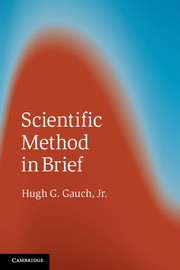Book contents
- Frontmatter
- Contents
- Foreword
- Preface
- 1 Introduction
- 2 Four bold claims
- 3 A brief history of truth
- 4 Science's contested rationality
- 5 Science's presuppositions
- 6 Science's powers and limits
- 7 Deductive logic
- 8 Probability
- 9 Inductive logic and statistics
- 10 Parsimony and efficiency
- 11 Case studies
- 12 Ethics and responsibilities
- 13 Science education
- 14 Conclusions
- References
- Index
1 - Introduction
Published online by Cambridge University Press: 05 November 2012
- Frontmatter
- Contents
- Foreword
- Preface
- 1 Introduction
- 2 Four bold claims
- 3 A brief history of truth
- 4 Science's contested rationality
- 5 Science's presuppositions
- 6 Science's powers and limits
- 7 Deductive logic
- 8 Probability
- 9 Inductive logic and statistics
- 10 Parsimony and efficiency
- 11 Case studies
- 12 Ethics and responsibilities
- 13 Science education
- 14 Conclusions
- References
- Index
Summary
Science and technology have immense cultural and economic significance. They transform much of what we encounter in daily life. Obvious examples are the computers, phones, and consumer electronics that change and improve noticeably on a timescale of merely a year. For instance, compared to the first flash drive for my computer that I purchased in the early 2000s, now a faster and smaller flash drive with 64 times as much memory costs only a quarter as much. This equates to the memory per dollar almost doubling annually.
Furthermore, scientific transformation is pervasive, even when not so obvious. For instance, a simple loaf of bread or bowl of rice seems like a low-tech product that is the same as it was decades ago. Not so! Wheat rust, rice blast, and other crop diseases are continually evolving new virulent strains that threaten current crop varieties. The ongoing efforts of plant breeders are necessary to protect crops from diseases, to increase yields, and to improve nutritional and other traits. The rate of change for our crops is so rapid that few varieties are still competitive after only seven or eight years. Were plant breeders to stop their work, the disease problems within a decade for wheat, rice, corn, potatoes, and other major crops would be catastrophic. So, the loaf of bread that you buy today, or the bowl of rice that you eat today, is a high-tech product that sophisticated and energetic scientific efforts have rendered quite different from its predecessors of a decade ago. My own scientific work from 1970 to the present has been developing statistical methods and software for these agricultural researchers.
- Type
- Chapter
- Information
- Scientific Method in Brief , pp. 1 - 20Publisher: Cambridge University PressPrint publication year: 2012

